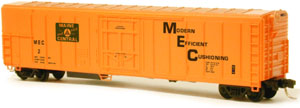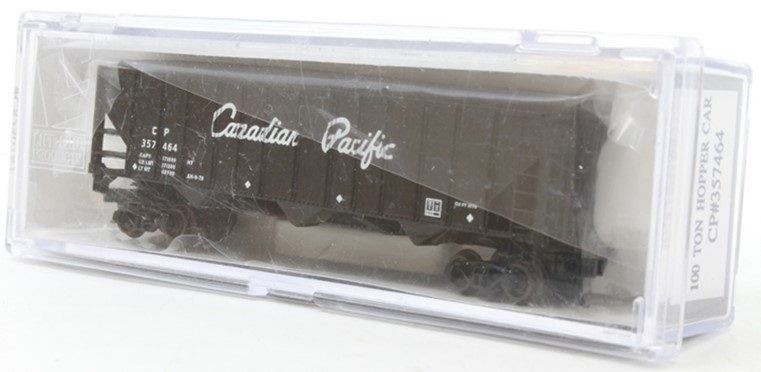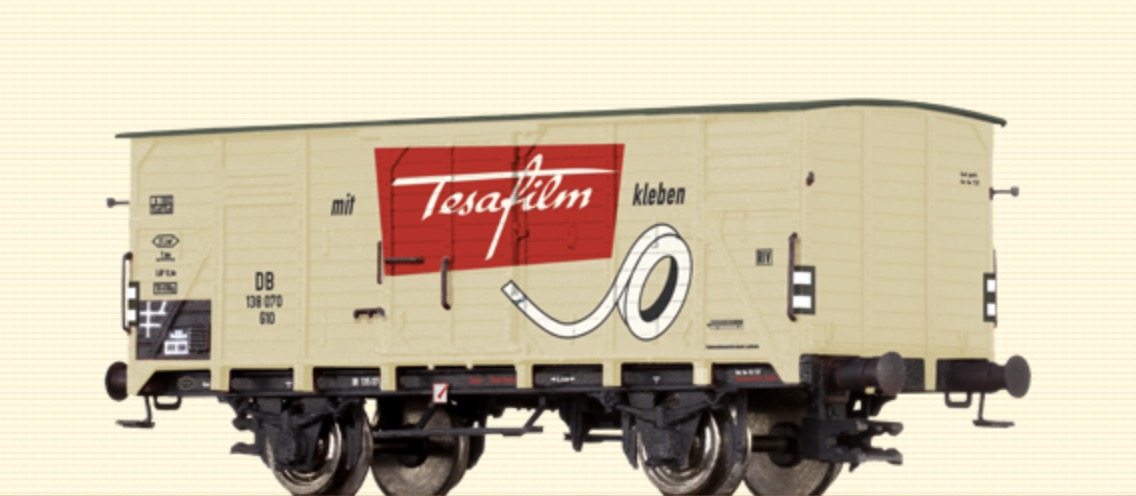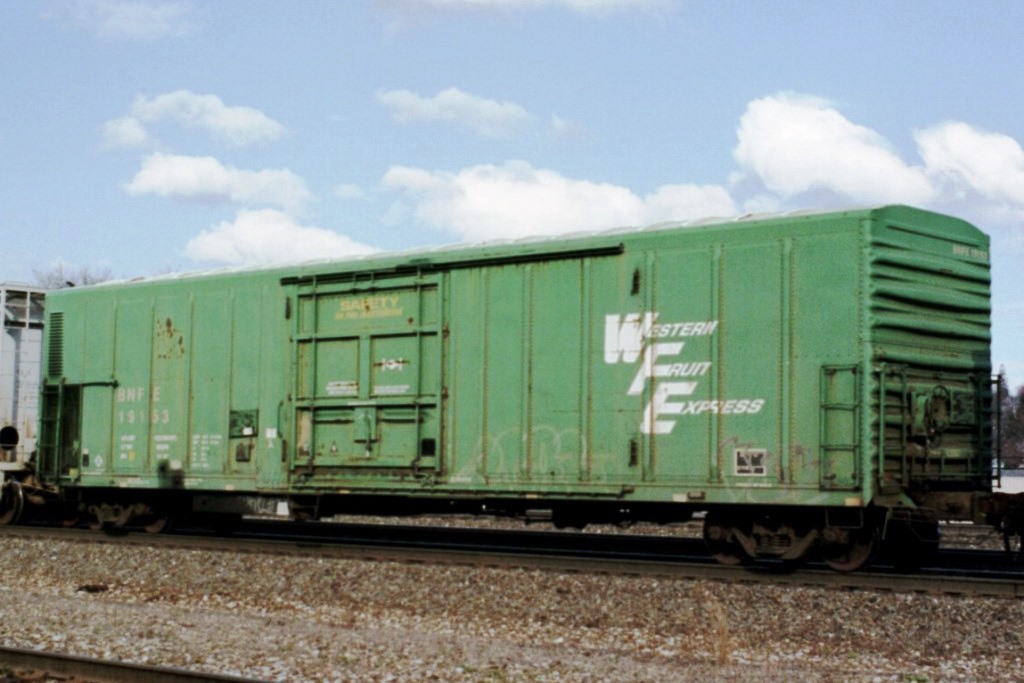Prototype History: Pacific Car and Foundry responded to the railroad’s migration from ice stored in bunkers as a primary cooling system to the diesel mechanical systems. The mechanical reefers could keep a more regular temperature, often times colder then what the ice bunker cars could at the time. Initially mechanical reefers were used primarily in frozen food service. This would soon change as mechanical refrigeration began to replace ice-based systems. Soon after, mechanical refrigeration units replaced the “armies” of personnel required to re-ice the cars. Several different deliveries of the PC&F 57’ mechanical to many different railroads in the mid to late 1960s. Many have been rebuilt and are still in service today.
These 50'-10" mechanical refrigerator cars were built by PC&F in 1969-70 and featured 4269 ft3 capacity and a 10'-6" door opening. Note that this body style is sometimes referred to as 57', however, the mechanical refrigeration eqipment takes up space on one end of the car thus leaving a nominal 50' usable inside length for loading. Bangor and Aroostook often leased it’s reefer fleet to Pacific Fruit Express in the off season for the railroad. This turned out to be a peak season for PFE in California. Green Bay and Western purchased several classes of 57’ Mechanicals from the BAR. Many were hastily patched and put into service. The GB&W cars were often seen on the North Western Pacific in California carrying butter from the Humbolt Bay to eastern markets.
These 50'-10" mechanical refrigerator cars were built by PC&F in 1969-70 and featured 4269 ft3 capacity and a 10'-6" door opening. Note that this body style is sometimes referred to as 57', however, the mechanical refrigeration eqipment takes up space on one end of the car thus leaving a nominal 50' usable inside length for loading. Bangor and Aroostook often leased it’s reefer fleet to Pacific Fruit Express in the off season for the railroad. This turned out to be a peak season for PFE in California. Green Bay and Western purchased several classes of 57’ Mechanicals from the BAR. Many were hastily patched and put into service. The GB&W cars were often seen on the North Western Pacific in California carrying butter from the Humbolt Bay to eastern markets.
Road Name History: 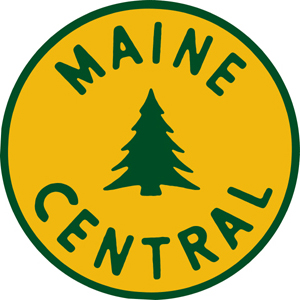 The Maine Central Railroad Company (reporting mark MEC) was a former U. S. Class I railroad in central and southern Maine. It was chartered in 1856 and began operations in 1862. By 1884, Maine Central was the longest railroad in New England. Maine Central had expanded to 1,358 miles (2,185 km) when the United States Railroad Administration assumed control in 1917. The main line extended from South Portland, Maine, east to the Canada?United States border with New Brunswick, and a Mountain Division extended west from Portland to Vermont and north into Quebec. The main line was double track from South Portland to Royal Junction, where it split into a "lower road" through Brunswick and Augusta and a "back road" through Lewiston which converged at Waterville into single track to Bangor and points east. Branch lines served the industrial center of Rumford, a resort hotel on Moosehead Lake, and coastal communities from Bath to Eastport.
The Maine Central Railroad Company (reporting mark MEC) was a former U. S. Class I railroad in central and southern Maine. It was chartered in 1856 and began operations in 1862. By 1884, Maine Central was the longest railroad in New England. Maine Central had expanded to 1,358 miles (2,185 km) when the United States Railroad Administration assumed control in 1917. The main line extended from South Portland, Maine, east to the Canada?United States border with New Brunswick, and a Mountain Division extended west from Portland to Vermont and north into Quebec. The main line was double track from South Portland to Royal Junction, where it split into a "lower road" through Brunswick and Augusta and a "back road" through Lewiston which converged at Waterville into single track to Bangor and points east. Branch lines served the industrial center of Rumford, a resort hotel on Moosehead Lake, and coastal communities from Bath to Eastport.
At the end of 1970 it operated 921 miles (1,482 km) of road on 1,183 miles (1,904 km) of track; that year it reported 950 million ton-miles of revenue freight. The Maine Central remained independent until 1981, when it became part of what is now the Pan Am Railways network in 1981.
From Wikipedia

At the end of 1970 it operated 921 miles (1,482 km) of road on 1,183 miles (1,904 km) of track; that year it reported 950 million ton-miles of revenue freight. The Maine Central remained independent until 1981, when it became part of what is now the Pan Am Railways network in 1981.
From Wikipedia
Brand/Importer Information:  Originally Red Caboose was a manufacturer of HO and N Scale model railroading items. It was located in Mead, Colorado, and was founded in 1990 by Leon Fairbanks.
Red Caboose manufactured highly accurate, well detailed N, HO, and O Scale freight cars and locomotives.
Originally Red Caboose was a manufacturer of HO and N Scale model railroading items. It was located in Mead, Colorado, and was founded in 1990 by Leon Fairbanks.
Red Caboose manufactured highly accurate, well detailed N, HO, and O Scale freight cars and locomotives.
Red Caboose closed its doors in January of 2015. Red Caboose N Scale has been sold to Fox Valley Models and HO was sold to InterMountain Railway. Many of the Red Caboose toolings have seen re-releases from Fox Valley since the acquisition. We just wish they would clean up the underframes. Red Caboose always went light on the details where they thought people wouldn't look.

Red Caboose closed its doors in January of 2015. Red Caboose N Scale has been sold to Fox Valley Models and HO was sold to InterMountain Railway. Many of the Red Caboose toolings have seen re-releases from Fox Valley since the acquisition. We just wish they would clean up the underframes. Red Caboose always went light on the details where they thought people wouldn't look.
Manufacturer Information: While they were in business, Red Caboose split its production runs between the US and China. Which models were produced where was a function of which body style and which run. Furthermore, which Chinese company was used for production is something we would love to find out.
Item created by: CNW400 on 2021-02-17 10:58:43. Last edited by CNW400 on 2022-02-09 10:01:28
If you see errors or missing data in this entry, please feel free to log in and edit it. Anyone with a Gmail account can log in instantly.
If you see errors or missing data in this entry, please feel free to log in and edit it. Anyone with a Gmail account can log in instantly.


